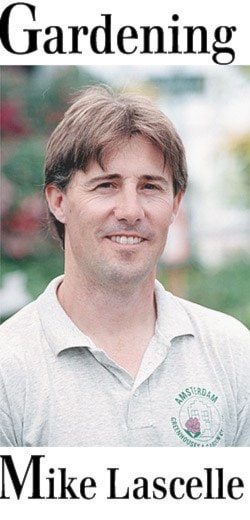A lot of people have been asking me lately about plants for shade gardens.
Let’s start by classifying shade: deep shade could be defined as no direct sunlight, as in an understory garden beneath a tree canopy or foundation beds against the north side of a tall building; partial shade would include filtered sunlight or a few hours of early morning (up to 11 a.m.) or late afternoon (after 5 p.m.) sun, with shade for the rest of the day.
The 12-4 p.m. sun exposure slot should be avoided for most shade-loving plants as these tend to scorch in the intense heat.
Your choices for shade-tolerant trees are quite limited, with the best being our native Vine maple (Acer circinatum), which naturally grows in the forest understory and green-leaved Japanese maples (Acer palmatum), such as ‘Seiryu’, ‘Koto No Ito’ and the weeping ‘Waterfall’. All of these will only have yellow autumn colour at best, as the rich red and orange hues are only produced by trees grown with more sun.
There are several tall shrubs to choose from, including the evergreen Japanese aralia (Fatsia japonica), which much resembles a glossy tropical plant (it can actually be grown indoors) – it has spherical white flower clusters and reaches heights of 2.5 metres.
Aucuba japonica is another broadleaf evergreen averaging 1.5-2 m in height, with the most common cultivars being ‘Picturata’ (gold inset variegation) and ‘Gold Dust’ (gold spots). These shrubs also make good informal hedging.
There are several deciduous options, including the lovely lacecap Hydrangea serrata, with ‘Bluebird’ being an easy-to- find variety.
Last on our list of tall shade-tolerant shrubs is the Japanese rose or Kerria japonica ‘Pleniflora’. This arching deciduous shrub features elegant green stems and pom-pom bright yellow flower clusters that really stand out in primarily green shade gardens.
Small to medium shrubs are generally limited to Sarcococca and Skimmia. Sarcococca or Christmas box are grown for their glossy evergreen foliage and sweetly fragrant white winter blooms, the species confusa and ruscifolia reach 1.2 m high, while the compact hookeriana var. humilis only grows to 45 centimetres, like a dense groundcover.
Skimmia japonica come in both male and female cultivars, with the latter needing at least one male plant for pollen in order to produce their red berries – the only exception being ‘Reevesiana’, which is self-fertile. Male clones such as ‘Rubinetta’ and ‘Rubella’ are grown for their abundant red flower buds (which look like berries) held through winter, opening to fragrant white spring flowers.
There’s a new variegated male cultivar called ‘Magic Marlot’ just on the market, it features heavy cream marginal variegation, red flower buds and fragrant pale pink blossoms. This latter introduction would be a great addition to any shade planter.
Last but not least are the perennials, so let’s start with ferns. Too many of you are casually passing them up because you just assume that they are all green – but there are actually a number of ferns with unusual foliar colour, among them Athyrium x ‘Ghost’ (milky-green), Dryopteris erythrosora or autumn fern (coppery-red new growth), Athyrium ‘Lady in Red” (red stems) and the purple-tinted Japanese painted fern (Athyrium nipponicum ‘Pictum’). Many of you hold similar biases towards grasses, again assuming that none are shade tolerant. The elegant Hakonechloa, with their arching foliage, come in bright gold (‘All Gold’), white-striped (‘Albo-striata’) and gold-striped- green (‘Aureola’), all of which also work well in containers. If you need some evergreen grasses, try the reliable sedges Carex ‘Evergold’ and ‘Ice Dance’.
For flowering perennials that also provide some foliar interest after flowering, use Brunnera macrophylla ‘Jack Frost,’ with its blue forget-me-not blooms and green-veined silver foliage, and Epimedium x rubrum or red bishop’s hat, with its tiny rose-red flowers and bronzed foliage.
Mike Lascelle is a local nursery manager and gardening author. Email him at hebe_acer@hotmail.com and visit his blog Soul of a Gardener.
